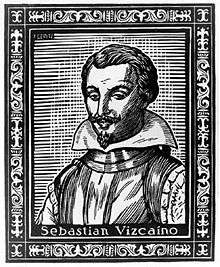Sebastián Vizcaíno
Sebastián Vizcaíno (1548–1624) was a Spanish soldier, entrepreneur, explorer, and diplomat whose varied roles took him to New Spain, the Philippines, the Baja California peninsula, the California coast and Japan.
Sebastián Vizcaíno | |
|---|---|
 | |
| Born | ca. 1548 |
| Died | 1624 (aged 75–76) |
| Nationality | Spanish |
Early career
Vizcaíno was born in 1548, in Extremadura, Crown of Castile (Spain). He saw military service in the Spanish invasion of Portugal during 1580–1583. Coming to New Spain in 1583, he sailed as a merchant on a Manila galleon to the Philippines in 1586–1589. In 1587, he was on board the Santa Ana as one of the merchants when Thomas Cavendish captured it, robbing him and others of their personal cargoes of gold.
The Californias
In 1593, the disputed concession for pearl fishing on the western shores of the Gulf of California was transferred to Vizcaíno. He succeeded in sailing with three ships to La Paz, Baja California Sur in 1596. He gave this site (known to Hernándo Cortés as Santa Cruz) its modern name and attempted to establish a settlement. However, problems of resupply, declining morale, and a fire soon forced its abandonment.
In 1601, the Spanish Viceroy in Mexico City, the Conde de Monterrey, appointed Vizcaíno general-in-charge of a second expedition: to locate safe harbors in Alta California for Spanish Manila galleons to use on their return voyage to Acapulco from Manila. He was also given the mandate to map in detail the California coastline that Juan Rodríguez Cabrillo had first reconnoitered 60 years earlier. He departed Acapulco with three ships on May 5, 1602. His flagship was the San Diego and the other two ships were the San Tomás and the Tres Reyes.
On November 10, 1602, Vizcaíno entered and named San Diego Bay. Sailing up the coast, Vizcaíno named many prominent features such as the Santa Barbara Channel Islands, Point Conception, the Santa Lucia Mountains, Point Lobos, Carmel River and Monterey Bay (thus obliterating some of the names given these same features by Cabrillo in 1542). He was the first person in recorded history to note certain ecological features of the California coast such as the Monterey cypress forest at Point Lobos.
The commander of the Tres Reyes, Martín de Aguilar, became separated from Vizcaíno and continued up the coast to present-day Oregon as far as Cape Blanco and possibly to Coos Bay.[1][2][3]
Much of what we know about Vizcaíno's Pacific Coast voyage is from the diary of Antonio de la Ascensión,[4] a Carmelite friar, chronicler and cosmographer who traveled with the expedition.[5]
One result of Vizcaíno's voyage was a flurry of enthusiasm for establishing a Spanish settlement at Monterey, but this was ultimately deferred for another 167 years after the Conde de Monterrey left to become Viceroy of Peru and his successor was less favorable. A colonizing expedition was authorized in 1606 for 1607, but was delayed and then canceled in 1608.[6]
Japanese relations

In 1611, Vizcaíno carried a Japanese delegation led by Tanaka Shōsuke from Mexico back to Japan. In an ambassadorial capacity, Vizcaíno met with the shōgun Tokugawa Hidetada and his father, the retired first shōgun, Tokugawa Ieyasu, founder of the Tokugawa dynasty. However, diplomacy soured due to Vizcaíno's disregard of Japanese court etiquette. After taking his leave in 1612, he surveyed the east coast of Japan and searched for two mythical islands called Rico de Oro and Rico de Plata. Failing to find them, he returned to Japan.
In 1613, Vizcaíno accompanied the Japanese embassy led by Hasekura Tsunenaga to Mexico. In Acapulco, Vizcaíno was seriously injured in a fight with the Japanese, as recorded by 17th-century Aztec historian Chimalpahin in his journal, "Annals of His Time." The Japanese entourage continued to Mexico City, and embarked a ship at Veracruz bound for Europe.
Dutch conflict
On November 11, 1616, Vizcaíno commanded 200 men at the port of Salagua against an attack by 200 Dutch pirates. In the afternoon, both sides ran out of ammunition. Vizcaíno's men retreated after the Dutch returned with more ammunition.[7]
Death
Sebastián Vizcaíno died in 1624 in Mexico City, New Spain.
Notes
- Cogswell, Jr., Philip (1977). Capitol Names: Individuals Woven Into Oregon's History. Portland, OR: Oregon Historical Society. pp. 9–10.
- LaLande, Jeff. "Cape Blanco". The Oregon Encyclopedia. Retrieved April 28, 2014.
- McArthur, Lewis A.; McArthur, Lewis L. (2003) [1928]. Oregon Geographic Names (7th ed.). Portland, Oregon: Oregon Historical Society Press. pp. 159–160. ISBN 978-0875952772.
- See the article on Antonio de la Ascensión in Wikipedia.sp
- English edition online at American Journeys, excerpted from "Spanish Exploration in the Southwest, 1542-1706", by Herbert Eugene Bolton (editor). (New York: Charles Scribner's Sons, 1916). Pages 104-134.
- Cutter (1978)
- Gerhard (2003)
References
- Chapman, Charles E. (1920). "Sebastian Vizcaino: Exploration of California". The Southwestern Historical Quarterly. 23 (4): 285–301.
- Cook, Warren L. (1973). Flood Tide of Empire. Yale University Press. pp. 9–11.
- Cutter, Donald C. (1978). "Plans for the Occupation of Upper California A New Look at the "Dark Age" from 1602 to 1769". The Journal of San Diego History. San Diego Historical Society. 24 (1).
- Gerhard, Peter (2003). Pirates of New Spain, 1575-1742. Mineola, NY: Dover Publications. pp. 117–119. ISBN 0-486-42611-4.
- Hayes, Derek (2003). Historical Atlas of the North Pacific Ocean. p. 31.
- Mathes, W. Michael (1965). Californiana I: documentos para la historia de la demarcación comercial de California, 1583-1632. Madrid: José Porrúa Turanzas.
- Mathes, W. Michael (1968). Vizcaíno and Spanish Expansion in the Pacific Ocean, 1580-1630. California Historical Society.
- Wagner, Henry R. (1928). "Spanish Voyages to the Northwest Coast in the Sixteenth Century. Chapter X: The Antecedents of Sebastian Vizcaino's Voyage of 1602". California Historical Society Quarterly. 7 (3): 256–276.